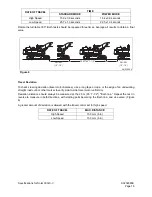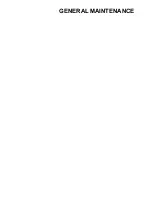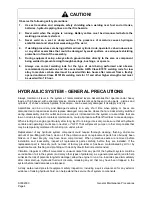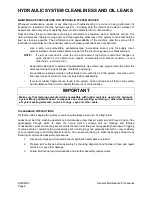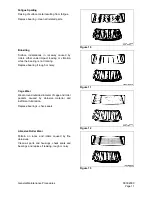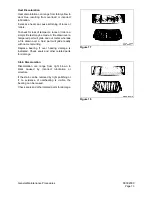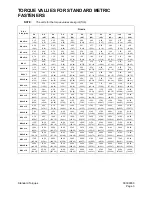
S0302000
Page 6
General Maintenance Procedures
Return to Master Table of Contents
HYDRAULIC SYSTEM CLEANLINESS AND OIL LEAKS
MAINTENANCE PRECAUTIONS FOR HYDRAULIC SYSTEM SERVICE
Whenever maintenance, repairs or any other type of troubleshooting or service is being performed, it’s
important to remember that the hydraulic system - including both the interior and exterior surfaces of
assemblies, and every drop of operating fluid - must be protected from contamination.
Dust and other foreign contaminants are major contributors to premature wear in hydraulic circuits. The
narrow tolerances, rapidly moving parts and high operating pressures of the system require that fluid be
kept as clean as possible. The performance and dependability of the machine (and the service lift of
individual components) can be noticeably reduced if proper precautions are not observed:
•
Use a safe, non-combustible, evaporative-type, low-residue solvent and thoroughly clean
exterior surfaces of assemblies before any part of the circuit is opened up or disassembled.
NOTE:
It’s just as important to clean the cap and reservoir top before routine fluid changes or
quick checks as it is before major repairs. (Accumulated dirt attracts moisture, oil and
other fluids - and more dirt.)
•
Keep dismantled parts covered during disassembly. Use clean caps, plugs or tape to protect the
disconnected openings of flanges, manifolds and piping.
•
Do not allow cleaning solvents or other fluids to mix with the oil in the system. Use clean oil to
flush any traces of solvent or other residue before reassembly.
•
If metal or rubber fragments are found in the system, flush and replace all fluid in the system
and troubleshoot the circuit to identify the source of contamination.
OIL LEAKAGE PRECAUTIONS
Oil that is visibly seeping from joints or seals should always serve as a "red flag" alarm.
Leaks must alert the machine operator and maintenance crew that air, water and dirt have an open, free
passageway through which to enter the circuit. Harsh, corrosive salt air, freezing and thawing
condensation cycles and working environments that are full of fine dust are especially hazardous. Clogging
of valve spools or external piping (especially pilot circuit piping) can gradually diminish or very suddenly
put a complete stop to normal hydraulic function. You can prevent having to make these types of repairs by
following recommended assembly procedures:
1.
Use new O-rings and oil seals whenever hydraulic assemblies are rebuilt.
2.
Prepare joint surfaces before assembly by checking alignment and flatness. Clean and repair
corrosion or any other damage.
3.
Follow bolt torque recommendations and all other assembly requirements.
IMPORTANT
Make sure that cleaning solvents will be compatible with rubber materials used in the hydraulic
system. Many petroleum based compounds can cause swelling, softening, or other deterioration
of system sealing elements, such as O-rings, caps and other seals.
Summary of Contents for Solar 300LC-V
Page 2: ......
Page 4: ......
Page 7: ...1SAFETY...
Page 8: ......
Page 46: ...S0102000 Page 38 Track Excavator Safety...
Page 47: ...1SPECIFICATIONS...
Page 48: ......
Page 54: ...S0202080K Page 6 Specifications for Solar 300LC V...
Page 70: ...S0202080K Page 22 Specifications for Solar 300LC V...
Page 71: ...1GENERAL MAINTENANCE...
Page 72: ......
Page 86: ...S0302000 Page 14 General Maintenance Procedures Return to Master Table of Contents...
Page 99: ...1UPPER STRUCTURE...
Page 100: ......
Page 102: ...S0402040K Page 2 Cab TABLE OF CONTENTS Removal 3 Installation 6...
Page 116: ...S0403050K Page 8 Counterweight Return to Master Table of Contents...
Page 140: ...S0407000 Page 6 Swing Bearing...
Page 164: ...S0408070K Page 24 Swing Reduction Gear...
Page 165: ...1LOWER STRUCTURE AND CHASSIS...
Page 166: ......
Page 190: ...S0505000 Page 24 Track Assembly 7 Tighten plug 1 Figure 48 Figure 48...
Page 191: ...S0505000 Page 25 Track Assembly TRACK SPRING AND TRACK ADJUSTING CYLINDER PARTS LIST Figure 49...
Page 193: ...1ENGINE AND DRIVE TRAIN...
Page 194: ......
Page 205: ...S0605060K Page 11 Air Conditioner Face and Defroster ARS1300L Figure 12...
Page 220: ...S0605060K Page 26 Air Conditioner...
Page 229: ...1HYDRAULICS...
Page 230: ......
Page 262: ...S0703010K Page 2 Accumulator TABLE OF CONTENTS General Description 3 Specifications 4...
Page 266: ...S0703010K Page 6 Accumulator...
Page 274: ...S0704080K Page 8 Center Joint Swivel...
Page 283: ...S0705000 Page 9 Cylinders...
Page 287: ...S0705000 Page 13 Cylinders...
Page 291: ...S0705000 Page 17 Cylinders...
Page 299: ...S0705000 Page 25 Cylinders...
Page 308: ...S0705000 Page 34 Cylinders 17 Force out pin bushing 1 from body of cylinder Figure 28...
Page 312: ...S0705000 Page 38 Cylinders...
Page 324: ...S0707270K Page 12 Swing Motor Toshiba MFC200 PARTS LIST Figure 6...
Page 355: ...S0707315K Page 11 Travel Motor with Gearbox...
Page 424: ...S0708315K Page 28 Main Pump Kawasaki CONSTRUCTION OF REGULATOR Figure 22...
Page 444: ...S0708315K Page 48 Main Pump Kawasaki...
Page 450: ...S0709401K Page 6 Main Control Valve Kayaba Figure 1...
Page 451: ...S0709401K Page 7 Main Control Valve Kayaba Figure 2...
Page 453: ...S0709401K Page 9 Main Control Valve Kayaba...
Page 455: ...S0709401K Page 11 Main Control Valve Kayaba Figure 4...
Page 467: ...S0709401K Page 23 Main Control Valve Kayaba Figure 16...
Page 500: ...S0709401K Page 56 Main Control Valve Kayaba Figure 54...
Page 552: ...S0792160K Page 6 Hydraulic Schematic S300LC V...
Page 553: ...1ELECTRICAL SYSTEM...
Page 554: ......
Page 608: ...S0802220K Page 54 Electrical System...
Page 627: ...S0802220K Page 73 Electrical System...
Page 634: ...S0892160K Page 4 Electrical Schematic S300LC V SOLAR 300LC V Figure 2...
Page 636: ...S0892160K Page 6 Electrical Schematic S300LC V...
Page 637: ...1ATTACHMENTS...
Page 638: ......
Page 658: ......




